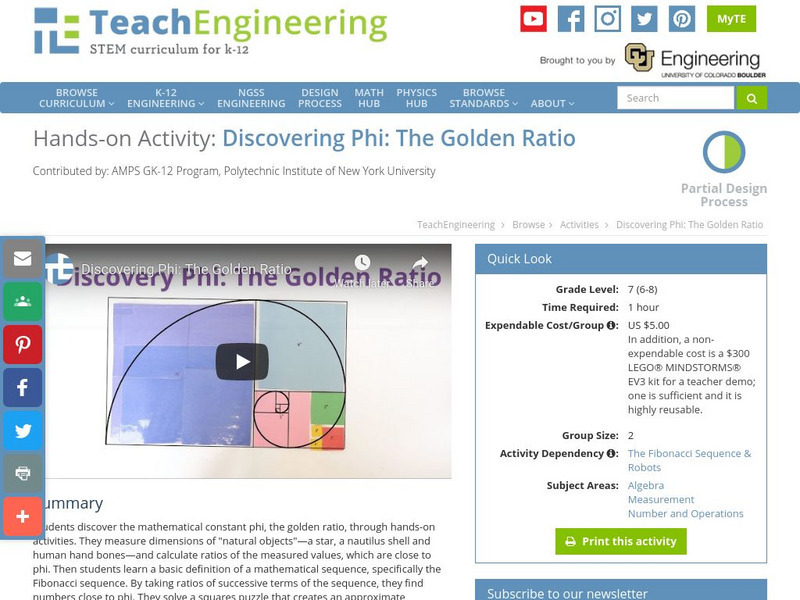Hi, what do you want to do?
MENSA Education & Research Foundation
Fabulous Fibonacci and His Nifty Numbers
Fibonacci numbers are not only found in the classroom but also in nature. Explore the concept of Fibonacci numbers through a series of lessons designed to gain insight into the mathematical reasoning behind the number pattern, and spark...
Teach Engineering
The Fibonacci Sequence and Robots
What better way to introduce the idea of a sequence than with robots! An educational activity explains the classic Fibonacci sequence before pupils build and program a robot to move. Additionally, the activity challenges individuals to...
Curated OER
Spiral Patterns in Art
In this art worksheet, students view a picture of Alexander Calder's sculpture "Black, White, and Ten Red." They analyze the sculpture by first finding the "rule" in the Fibonacci sequence. Students read a paragraph about where the...
Curated OER
Patterns in Nature
In this patterns in nature learning exercise, students read about the Fibonacci Spiral, then follow the directions to plot one on the graph paper and draw the spiral, with links to more information.
Teach Engineering
Discovering Phi: The Golden Ratio
Fe, phi, fo, fum. This activity leads pairs to find the ratio of consecutive terms of the Fibonacci sequence. The pairs find that the Fibonacci sequence can be found in many places. A discussion with the class shows that the ratios...
Curated OER
There's Gold in Them Thar Ratios
Students draw a model of the bunny problem which generates the Fibonacci Sequence, spirals generated from golden rectangles and golden triangles; identify the golden ratio in the human body, and find the Fibonacci numbers in nature.
Curated OER
Patterns Across Cultures: The Fibonacci Sequence in Visual Art
Students study the origin of the Fibonacci Sequence. In this investigative instructional activity students identify works of art where Golden Spiral or Ratio appear.
Curated OER
The Golden Rectangle
Middle schoolers explore the concept of the golden ratio. In this golden ratio lesson, students measure objects to determine if their measurements fit the golden ratio. Middle schoolers calculate the average measurements of the class.
Curated OER
Number Patterns and Sequences
In this number patterns and sequences worksheets, students complete activities for number patterns and sequences including Fibonacci's Sequence, lines, regular polygons, and towers. Students complete 15 problems.
Curated OER
Using Ratios
Students study the Golden Ratio and its relationship to Renaissance artists. After exploring proportions and ratios used by Renaissance artists, students create a mix of ten variations of color paint, and record the ratios of primary...
Curated OER
Design, Grow, and Ponder in a Garden
A garden can inspire students to make mathematical connections.
Mathigon
Mathigon: Algebra: Fibonacci Numbers
This lesson focuses on Fibonacci numbers, a pattern based on the sum of the two previous numbers. It offers examples and practice exercises using some form of Fibonacci numbers.
Math Is Fun
Math Is Fun: Nature, the Golden Ratio, and Fibonacci, Too
Looks at how spirals form in nature when cells reproduce in a flower, for example. An interactive lets students try entering different values to see if they can make a spiral pattern with no gaps. The correct figure would be the Golden...
TeachEngineering
Teach Engineering: Discovering Phi: The Golden Ratio
Students discover the mathematical constant phi, the golden ratio, through hands-on activities. They measure dimensions of "natural objects"--a star, a nautilus shell and human hand bones--and calculate ratios of the measured values,...
Texas Instruments
Texas Instruments: At a Snail's Pace for the Ti 73 Explorer
It is hard to imagine a way to mathematically describe a spiral. Spirals are commonly seen in nature. There are a number of different types of spirals. Some interesting examples include the spiral arrangements of scales in pine cones,...
TED Talks
Ted: Ted Ed: Sponge Bob's House Is Not a Pineapple
Are SpongeBob's pants really square? Is Gary's shell a logarithmic spiral? No. But, how can we figure out if SpongeBob's house is actually a pineapple? There's math everywhere! Let's use Fibonacci numbers to help us determine this...




















